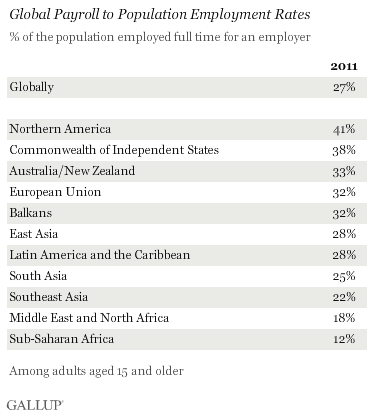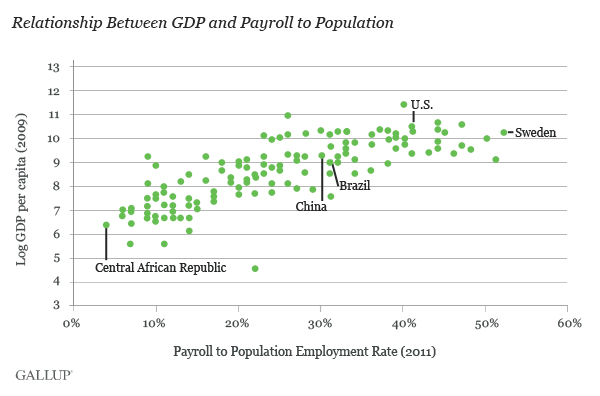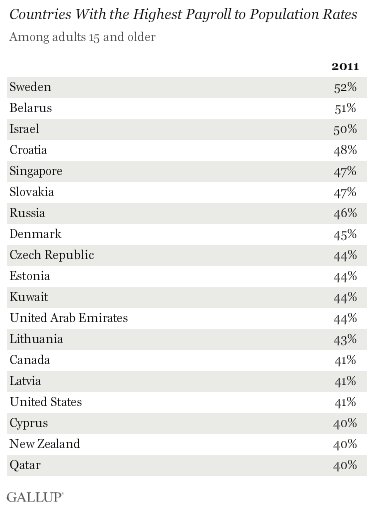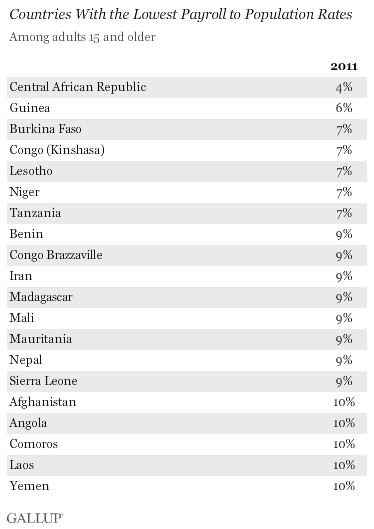WASHINGTON, D.C. -- Twenty-seven percent of the world's adults were employed full time for an employer in 2011, according to Gallup's new "Payroll to Population" metric. This new measure estimates the percentage of the entire 15 and older population -- not just those currently in the workforce -- who are employed full time for an employer for at least 30 hours per week. Worldwide, the Payroll to Population percentage was highest in Northern America, at 41%, and lowest in sub-Saharan Africa, at 12%.

Adults who are self-employed, working part time, unemployed, or out of the workforce are not counted as payroll-employed in the Payroll to Population metric. Gallup finds this new measure of employment to be more strongly related to GDP per capita than any other employment metric, including unemployment, which is traditionally the gold standard employment measure but relates little to GDP.

Payroll to Population provides a more accurate picture of the true economic situation in a country because it is not affected by changes in the workforce participation rate. When jobs are scarce, people may drop out of the workforce. This can actually lead to an improvement in unemployment rates, even though fewer people are working. Payroll to Population, on the other hand, declines when fewer people are working and rises when more people find full-time work.
Payroll to Population Lower in Developing Countries
Sweden, Belarus, and Israel had the highest Payroll to Population employment rates in the world in 2011 and were the only countries where the percentage was 50% or higher. Overall, 19 countries had a Payroll to Population percentage that was 40% or higher. Most of the countries at the top of the list had a large percentage of adults employed in the services sector, which includes government jobs.

On the other end of the spectrum, 20 countries had a Payroll to Population employment rate of 10% or less, meaning no more than one in 10 adults in these countries was working full time for an employer. Fifteen of those 20 countries are in sub-Saharan Africa, including the Central African Republic, the country with one of the lowest Payroll to Population percentages in the world. The majority of these countries are developing nations, where most working individuals are self-employed and thus not included in the Payroll to Population figures.

Not including the self-employed in Payroll to Population percentages may seem counterintuitive given the importance placed on entrepreneurship for creating jobs. However, self-employment in the developing world tends to be subsistence work and does little to help people rise out of poverty or contribute to the economic well-being of the country. Globally, self-employment is negatively correlated with GDP, meaning that the more people a country has working for themselves, the lower the GDP. Successful entrepreneurship does, however, often lead to businesses that create formal jobs, which in turn increases the number of people counted in Payroll to Population.
The countries at the bottom of the Payroll to Population list underscore this concept. Countries in sub-Saharan Africa have a higher number of people working for themselves than for employers, and they are generally in jobs that were created out of necessity rather than opportunity. Growth in the Payroll to Population figures in these countries would be an indicator that more people are securing quality formal jobs that contribute to economic growth.
Bottom Line
Gallup's Payroll to Population metric provides a new global measure with which to monitor the true employment situation worldwide. It provides an accurate measure of the percentage of people who are contributing to the economy of a country. Unlike unemployment rates, this percentage provides information about economic energy. For example, if a large generation retires with a smaller generation replacing it in the workforce, such as the baby boomers in the U.S., Payroll to Population declines. This means fewer people are sustaining the economy or contributing to the tax base. This decline in employment, which goes undetected with traditional employment measures, could mean trouble ahead. Alternatively, countries that see Payroll to Population rates increase will be well-positioned to achieve sustained economic growth.
For complete data sets or custom research from the more than 150 countries Gallup continually surveys, please contact us.
Survey Methods
Results are based on telephone and face-to-face interviews with 187,119 adults, aged 15 and older, conducted in 2011 in 148 countries and areas. For results based on the total global sample, one can say with 95% confidence that the maximum margin of sampling error is less than ±1 percentage points. For results based on regional samples, the margin of error ranges from a high of ±1.1 percentage points in the former Soviet Union to a low of less than ±1 percentage points in Asia. For results based on country-level samples, the margin of error ranges from a low of ±2.2 to a high of ±4.8. The margin of error reflects the influence of data weighting. In addition to sampling error, question wording and practical difficulties in conducting surveys can introduce error or bias into the findings of public opinion polls.
For more complete methodology and specific survey dates, please review Gallup's Country Data Set details.

